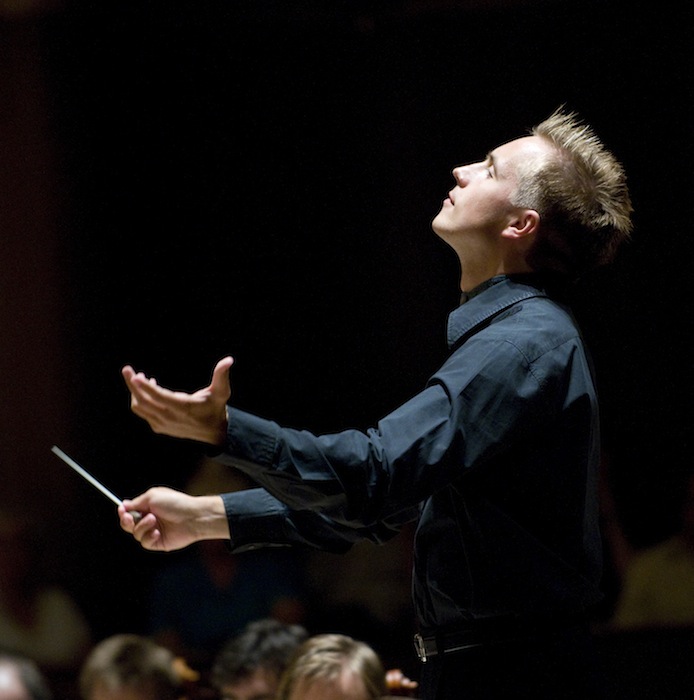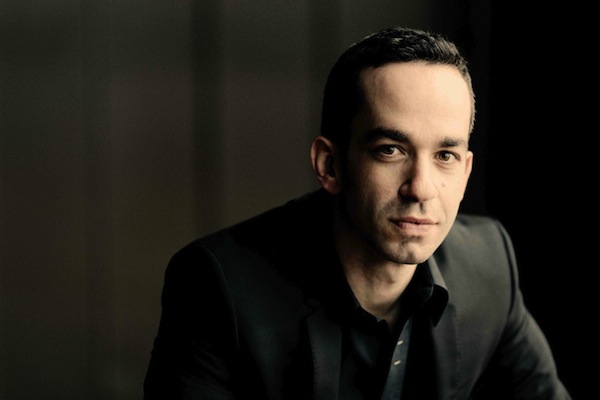Petrenko leads Baltimore Symphony in incendiary Shostakovich

Vasily Petrenko conducted the Baltimore Symphony Orchestra in music of Beethoven and Shostakovich Friday night at Meyerhoff Symphony Hall. Photo: Mark McNulty
Vasily Petrenko has had a long relationship with the Baltimore Symphony Orchestra over the years, but his last visit here was in 2011. In 2013, the Russian maestro took over as chief conductor of the Oslo Philharmonic, where his mentor Mariss Jansons made his mark. Petrenko returned to Baltimore this week to conduct a fierce and gorgeous rendition of Shostakovich’s Tenth Symphony Friday night at Meyerhoff Symphony Hall.
In 2013, Petrenko made a statement to a newspaper reporter in Norway that “orchestras react better when they have a man in front of them.” One suspected that he would not be invited back to conduct the ensemble of Marin Alsop, who at the time was just about to become the first woman to conduct the Last Night of the Proms in London. Petrenko later claimed that he was mistranslated.
Whatever his opinions on women conductors, the results Petrenko achieved at the podium were incendiary. As shown by his highly regarded Shostakovich cycle with the Liverpool Philharmonic on the Naxos label, the conductor is a supremely inspired exponent of this repertoire.
Although the Tenth Symphony was premiered around the time of Stalin’s death, it was hardly a moment of anti-Soviet liberation for Shostakovich, as sometimes claimed. By 1960, the composer had become a member of the Communist Party, an act that dispirited many actual dissidents at the time. By this point, as author Laurel Fay put it, Shostakovich “had ceded unconditionally his signature, his voice, his time, and his physical presence to all manner of propaganda legitimizing the Party.”
Petrenko never let the often understated first movement slacken, coaxing out a rich, string-dominated sound and whipping the ensemble into a menacing howl as needed. He kept the balances optimal around the orchestra, providing a comfortable sonic envelope to the delicate woodwind solos.
In the second movement Shostakovich quotes a folk dance from Georgia, the birthplace of Joseph Stalin, whose death coincided with the completion of this symphony in 1953. A maniacal tempo made the brutal second movement an unflinching account of bone-chilling terror.
Shostakovich reveals the symphony’s real subject matter in the third movement, with two themes that are juxtaposed for the rest of the piece. The Allegretto had a weighty dance-like feel, with the composer’s name theme plodding through it clumsily. A beautiful French horn solo calmed the music by introducing the other name theme, for the young pianist Elmira Nazirova. Shostakovich had gone to Azerbaijan to visit his former student in 1952, playing a recital there to a near-empty hall.
Shostakovich’s love was unrequited, but the story fits with Shostakovich’s vague description of the symphony’s program at the time as one of “human feelings and passion.” Near the end of the third movement, as some tender violin solos approached, one of the strings broke on concertmaster Jonathan Carney’s violin.
Without missing a beat, acting associate concertmaster Wyatt Underhill handed Carney his violin to use for the solos and quietly replaced the broken string in time for most of the fourth movement. Petrenko did not rush through the finale’s Andante’s slow-burning solos from oboe and flute. That made an agonizing setup for the concluding Allegro’s Offenbach-like galop punctuated by the return of the DSCH motif in a final, crazed declaration.
Petrenko’s strong hand at Beethoven was less expected. In the Overture to Coriolan the opening chords punctuated by stark silences were crisp and perfectly placed, a tribute to the efficiency and precision of Petrenko’s gestures. As in the Shostakovich the tender second theme was not allowed to wallow rhythmically, and the voicing across the orchestra brought out the lurking dissonances in some of the large brass chords.

Inon Barnatan. Photo: Marco Borggreve
Soloist Inon Barnatan gave a sensitive, beautifully shaded performance in Beethoven’s Piano Concerto No. 3. Petrenko helped shape the orchestral portions, with every phrase leading somewhere and receding, and strong dynamic contrasts and vivid articulations enlivened this familiar music.
The outer movements leaned fast and brilliant, so much so that the solo part lost some clarity around the edges in Barnatan’s hands. In the slow movement Petrenko tried to push Barnatan out of a somewhat self-indulgent tempo, driving forward where he could. Unfortunately, the Allegro tempo of the finale was already so fast, there was little room to speed up for the Presto finale.
The program will be repeated 8 p.m. Saturday in the Music Center at Strathmore and 3 p.m. Sunday at Meyerhoff Symphony Hall in Baltimore. http://www.bsomusic.org/calendar/events/2016-2017-events/shostakovichs-symphony-no-10.aspx



Posted Oct 15, 2016 at 5:08 pm by Robin Mitchell-Boyask
The author of this review has a very simplistic, outdated view of the life and music of Shostakovich. You don’t have to agree with every word of Testimony, but virtually every single Soviet musician would disagree with the characterization of the composer in this review.
Posted Oct 16, 2016 at 11:15 am by David Rohde
Thanks and three thoughts from the grand tier at Strathmore after Saturday night’s performance. First, there’s real immediacy to the woodwinds, almost as if they’re playing their solos in the same small room with you, and that “sonic envelope” you describe was especially notable. Second, simply the visuals from there were fantastic – in a work like Shostakovich 10 to be able to watch the contrabassoon, bass trombone and tuba plus all five percussionists work just adds to the depth of feeling and detailed understanding. Third and most important, nearby were two families with a total of three kids who were, shall we say, very restless during the two Beethoven works. Shostakovich – especially from the mountain in the middle of the first movement forward – completely different for them. I think we do a disservice when we get all “1953” and “Stalin’s death” about a great work like this in hyper-program-notes mode. Yes that’s part of it – maybe – but it is clear that it can also speak to young people in America in 2016 in ways maybe they couldn’t even verbalize (but wouldn’t that be part of the point of instrumental absolute music anyway). For pre-teens and teens who are not otherwise deeply engaged in serious music, maybe we should start them off with Shostakovich symphonies, maybe especially 10, 8 and 5, and Prokofiev piano sonatas and then move backwards to the classical and Romantic literature! Especially as guided and presented by Petrenko and anyone else who can truly match him.